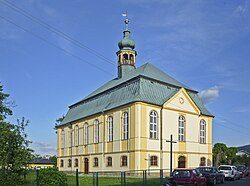Podgórzyn [pɔdˈɡuʐɨn] (German: Giersdorf) is a village in Jelenia Góra County, Lower Silesian Voivodeship, in south-western Poland.[1] It is the seat of the administrative district (gmina) called Gmina Podgórzyn.
Podgórzyn | |
|---|---|
Village | |
 Catholic Church of Our Lady of Częstochowa | |
| Coordinates: 50°49′57″N 15°41′1″E / 50.83250°N 15.68361°E | |
| Country | |
| Voivodeship | Lower Silesian |
| Powiat | Jelenia Góra |
| Gmina | Podgórzyn |
| First mentioned | 1318 |
| Population | |
• Total | 1,700 |
| Time zone | UTC+1 (CET) |
| • Summer (DST) | UTC+2 (CEST) |
| Vehicle registration | DJE |
It lies approximately 9 kilometres (6 mi) south-west of Jelenia Góra and 101 km (63 mi) west of the regional capital Wrocław.
History
editThe area became part of the emerging Polish state in the 10th century. Initially it was administratively part of the Wleń castellany.[2] The village was first mentioned in 1318, when it was part of fragmented Piast-ruled Poland.[3]
During World War II, in 1940–1942, the Germans used Belgian, French and Soviet prisoners of war and possibly also Czech and Polish civilians for forced labour to build a road connecting the village with Przełęcz Karkonoska, however, the construction was not completed.[4]
From 1911 to 1965, Podgórzyn was connected with Jelenia Góra by tram.[5]
Sights
editCultural heritage sights of Podgórzyn include the Baroque Our Lady of Częstochowa church and Holy Trinity church.
References
edit- ^ "Central Statistical Office (GUS) - TERYT (National Register of Territorial Land Apportionment Journal)" (in Polish). 2008-06-01.
- ^ Staffa, Marek (2001). Karkonosze (in Polish). Wrocław: Wydawnictwo Dolnośląskie. p. 40. ISBN 83-7023-560-3.
- ^ Staffa, p. 56
- ^ Przerwa, Tomasz (2020). "Zatrudnienie jeńców belgijskich, francuskich i radzieckich przy budowie Drogi na Przełęcz Karkonoską (Spindlerpaßstraße) 1940–1942". Łambinowicki rocznik muzealny (in Polish). 43. Opole: 5, 8–9, 16. ISSN 0137-5199.
- ^ Staffa, p. 221
External links
edit
